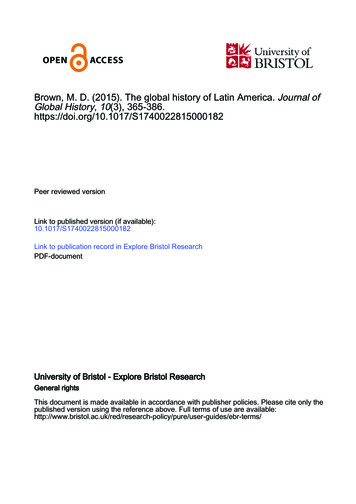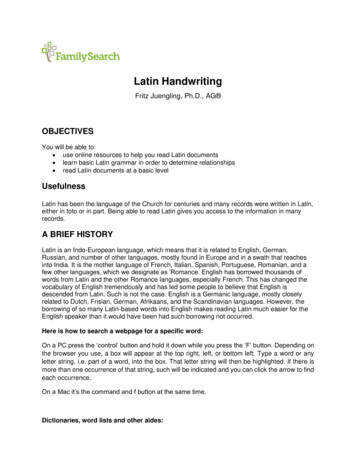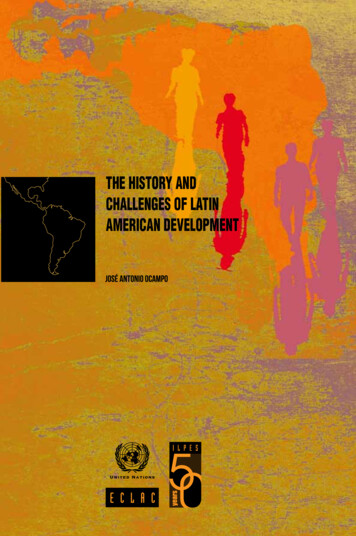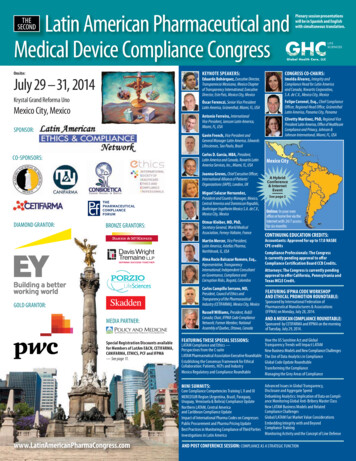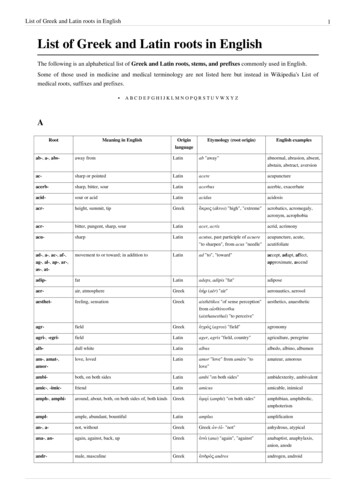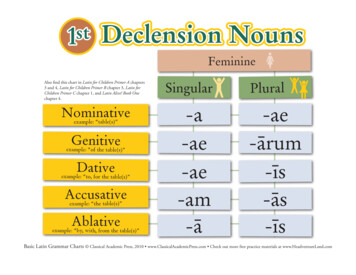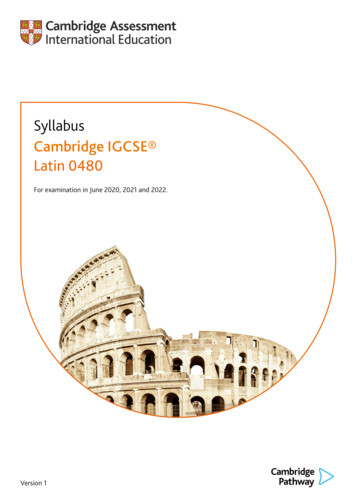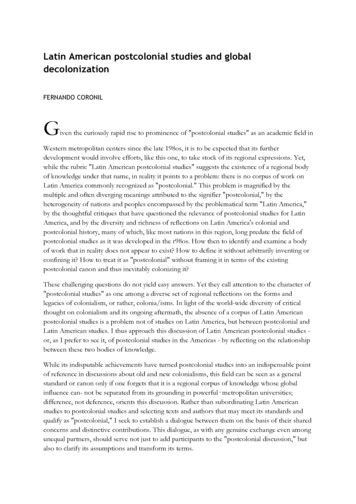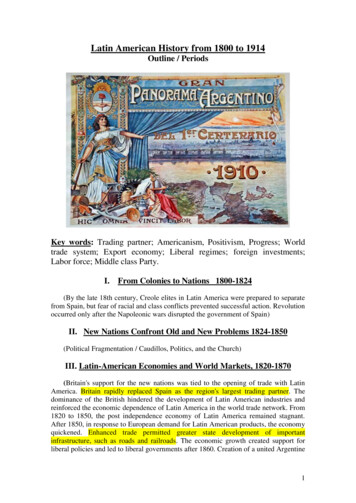
Transcription
Latin American History from 1800 to 1914Outline / PeriodsKey words: Trading partner; Americanism, Positivism, Progress; Worldtrade system; Export economy; Liberal regimes; foreign investments;Labor force; Middle class Party.I. From Colonies to Nations 1800-1824(By the late 18th century, Creole elites in Latin America were prepared to separatefrom Spain, but fear of racial and class conflicts prevented successful action. Revolutionoccurred only after the Napoleonic wars disrupted the government of Spain)II. New Nations Confront Old and New Problems 1824-1850(Political Fragmentation / Caudillos, Politics, and the Church)III. Latin-American Economies and World Markets, 1820-1870(Britain's support for the new nations was tied to the opening of trade with LatinAmerica. Britain rapidly replaced Spain as the region's largest trading partner. Thedominance of the British hindered the development of Latin American industries andreinforced the economic dependence of Latin America in the world trade network. From1820 to 1850, the post independence economy of Latin America remained stagnant.After 1850, in response to European demand for Latin American products, the economyquickened. Enhanced trade permitted greater state development of importantinfrastructure, such as roads and railroads. The economic growth created support forliberal policies and led to liberal governments after 1860. Creation of a united Argentine1
Republic in 1862. Liberal reformers sought to manipulate the economic boom after the1860s. Using profits from increased trade, the liberal government established educationsystems, built roads, and constructed railroads. The liberal government carried out thefinal conquest of Indians in Argentina.)IV. Societies in Search of Themselves 1800-1900(Latin American culture was torn between the heritage of Europe and the need toexpress Americanism. The end of Spanish colonial dominance opened Latin America toother European influences in the decades after independence. French neoclassicaltradition was particularly influential. Romanticism shifted Latin American attentions tosymbols of Americanism, such as Indians, gauchos, and slaves. Historical studiesreflected the European concepts of positivism and progress. By the 1870s, the politicaldominance of liberalism produced more realistic literary efforts, which often criticizedsocial and political systems. Popular culture remained largely unaffected by trendsamong the elite. Although legal distinctions were often removed, the old socialhierarchy based on color and ethnicity was tacitly retained. Indians remained virtuallyoutside the social system of Creoles and mestizos. Socially and economically, theliberal decades led to increasing control of resources, including land, by an elite ofwhite Creoles. After the 1870s, economic change and immigration fostered the creationof greater urban centers, but Latin America remained predominantly agrarian anddependent on the world trade system)V. The Great Boom and uncle Sam goes south, 1880-1920(The Latin American export economy produced a social and political alliancebetween large landowners, miners, and export merchants, all of whom depended oncommerce for prosperity. Exports dramatically increased between 1870 and 1900.The expanding economy attracted capital from abroad, both from Europe and the UnitedStates. Although foreign capital provided the impetus for expansion, it placed LatinAmerican industries and transportation corporations in foreign hands.)Mexico and Argentina: Examples of Economic TransformationMexico: Porfirio Díaz, one of Juárez's generals, was elected president of the Mexicanrepublic. As was typical of liberal regimes, Díaz's government attracted foreigninvestment, built up the nation's infrastructure, and initiated industrialization. Althoughthe appearance of democracy was retained, Díaz's government suppressed all politicalopposition. Much of the economic growth in Mexico was at the expense of urbanlaborers and the peasantry, both of which were largely Native American. In 1910,popular dissatisfaction with Díaz's regime resulted in the Mexican Revolution.Argentina also had a liberal government whose popularity depended on maintaining theboom in the export economy. Unlike Mexico, where labor was provided by indigenouspeoples, Argentina's labor force expanded through immigration from Europe. Europeanborn workers brought with them socialism, and a Socialist Party emerged in Argentinain the 1890s. A series of strikes followed by government repression typified the firstdecades of the 20th century. The middle-class Radical Party promised political reformand enlightened labor policies to gain power in 1916. When faced with strikes, it, too,reacted repressively. The models of Mexico and Argentina (oligarchies composed of thetraditional aristocracy and the middle classes uneasily presiding over disgruntled2
laborers and peasants) could be found in other Latin American states where liberalmodernization met resistance.Uncle Sam Goes SouthAmerican capitalists turned to Latin America for investment after the American CivilWar. The United States' first armed intervention in Latin America, the SpanishAmerican War between 1895 and 1898, was intended to open the door to the valuablesugar plantations of the Caribbean. As a result of the war, the former Spanish coloniesof Cuba and Puerto Rico were reduced to dependency on the United States. WhenColombia proved reluctant to support American plans in Central America, the UnitedStates backed Panama's independence movement in return for extensive rights to build acanal in the new nation. Latin American nations became increasingly critical of U.S.intervention in the region.Global Connections: New Latin American Nations and the World(During the 19th century, the former colonies of Latin America constructed newnations. There were many difficulties. Latin America was forced to forge economiesin a world trade network already dominated by European nations. Unlike much ofthe developing world, Latin America cast off European imperialism in the 19th century.The new nations carried with them colonial social systems that were strictly hierarchicaland in which a small Creole elite dominated the economy and politics. NativeAmericans, former slaves and peasants shared little in the economic expansion of thesecond half of the century. In a sense, Latin America was the first region of the world toundergo the problems of decolonization. Latin America maintained ties to the West byimitating Western models and because of the growing influence of the United States. Itsdependent economy also kept it connected to the world)3
Brasil, CafetalCopyright 1995-2010, Pearson Education, Inc., publishing as Pearson -------------Argentine History / Stages 1852 - 1930Felix Luna / A short history of the ArgentineansEditorial Planeta, 2003I. 1860-1880The shaping of institutions“Argentina was still sparsely populated but was constantly evolving and, in generalterms, improving. It was also receiving a steady immigration. ( ) The internationalscene was marked by peace and the availability of capital for foreign investments andscientific and technological advances.”1. Political mechanism in ArgentinaB. Bartolomé Mitre from 1862 to 1868, Domingo Sarmiento from 1868 to 1874 andNicolás Avellaneda from 1874 to 1880 consolidated the republican system2. Immigration3. The wheat and the cold“And then there was wheat. The first exports were made in 1878. They were only smallbut until that year Argentina had generally to import it from the United States. From1878 onwards there was a small surplus to sell abroad. But in only 30 years it becamethe most important of Argentine exports. In 1879 a piece of technology of enormoussignificance appeared: a ship that could transport several tons of frozen lamb to Europe,Le Frigorifique.4. A year of foundations – 18804
1880 marked the year of the end of the Conquest of the Desert. Second, two significantdevelopments that were unnoticed at the time became a fact of life: the export of smallamounts of wheat and the successful preservation of meat in cold storage. Third:Buenos Aires became the Nation s capital under Roca s presidency.II. 1880 - 1916The shaping of modern ArgentinaThe years between 1880 and 1810 or rather the milestone 1912 Sáenz Peña Law havecome to be known as the Conservative Order or the Conservative Regime.1. The Belle EpoquePeace, optimism, unlimited universal progress and liberal politics across the globe, freetrade and international business across the globe.2. A Nation in embryoThese three decades witnessed the birth of modern Argentina. Investment, productionand consumption placed Argentina among the most advanced countries in SouthAmerica. It had the longest Railroad network, an admirable educational system and asizeable middle class and a previously unknown political and institutional stability3. IdeologyIn this period Alberdi s ideology was put to practice to create a society that offered theright to gather wealth and educate their children. The parties shared a the policy ofopening up the borders of Argentina to the outside world. They introduced newtechnology like fencing and the Australian Wind mill and modern harvesters. They alsopromoted cross-breeding of cattle to improve races. Production was so profitable than inthirty years Argentina became the primary exporter of cereals in the world and thesecond largest exporter of frozen meat after the USA.4. DebtsCapital investment was needed to modernize Argentina.5. Immigration, Education, PeaceThe policy of the Conservative Regime depended on these three principles. Immigrationplus popular education inevitably meant that years later a new generation would wanttheir place on the political stage and govern the country. The law 1420 that madeprimary education compulsory and guaranteed that the students did not need to make aparticular religious confession was passed.6. The StateThe political thinking was liberal but the State had to be strong and authoritarian.5
7. Question MarksWith immigration, with the creation of an industrial infrastructure, the newlyestablished proletariat began to voice social grievances and strikes, unrest and theclaims of anarchist or socialist leaders reached the more advantaged classes. With thelaw of Residency, after 1904 and 1905, the system became to become more repressive.In the year 1912 the Saenz Peña Law replaced the slippery, fraudulent, violent electoralregime of previous years with a system in which citizens could vote freely and minoritycandidates could also govern alongside the victors.8. The price of progressProsperity depended to a large extent on production of the so called humid Pampas andcertain regions of the country were excluded. In the censuses increasing poverty wasreflected. Social growth was uneven and for many there were no social safety nets.There was no welfare state.Pabellón Argentino que participó de la Exposición Universal de París de 1889. (1)(1) Luego de su éxito en la capital francesa, fue desmontado y trasladado a BuenosAires, adonde funcionó como Museo de Bellas Artes desde 1910 hasta 1932,cuando fue demolido para ampliar la Plaza San Martín.(The Exposition Universelle of 1889 was a World's Fair held in Paris, Francefrom 6 May to 31 October 1889. It was held during the year of the 100thanniversary of the storming of the Bastille, an event traditionally considered asthe symbol for the beginning of the French Revolution. The fair included areconstruction of the Bastille and its surrounding neighborhood, but with theinterior courtyard covered with a blue ceiling decorated with fleur-de-lys andused as a ball room and gathering place.6
dominance of the British hindered the development of Latin American industries and reinforced the economic dependence of Latin America in the world trade network. From 1820 to 1850, the post independence economy of Latin America remained stagnant. After 1850, in response to European demand for Latin American products, the economy quickened.
